Central Asian Shepherd
Introduction of the Central Asian Shepherd
Central Asian Shepherd Dogs are thought to be ancestors of the most ancient breed known today. They are extremely noble and proud looking dogs that over time have proved themselves to be loyal courageous and devoted companions. They are often known as the Central Asian Ovcharka and today these handsome large dogs are gaining popularity elsewhere in the world which includes here in the UK although at the present time they are not recognised as a breed by The Kennel Club (June 2016).
History of the Central Asian Shepherd
Thought to be ancestors of one of the oldest breeds on the planet there are records of the Central Asian Shepherd Dog that date back over 5000 years. They have always been highly prized for their courage loyalty and devotion often having to work alongside man and other dogs in the challenging regions of Mongolia the northwest border of China the Urals Asia Minor and the Caspian Sea. In times long past there many different varieties of Central Asian Shepherd Dogs found in the various regions of the world where they were bred. However attempts to standardise the breed took place under the Soviet era during the 1920's.
More recently a different type of dog has appeared on the scene which is known as the Central Asian Ovcharka and although they are descendants of the original dog there is a difference in their size temperament and coat colours. With this said these handsome proud dogs are still thought to be the "purest" of all breeds having not been interfered with by man to the same extent as many other breeds that are around today.
Central Asian Shepherd Dogs are still used today in the Mongolian mountains and working alongside nomads that roam the lands right through to the Kara Kum deserts and their job remains the same as it always was which is to guard the people their animals and livestock in some of the harshest conditions on the planet. They are often referred to as the "Wolf Crusher" or "Volkodav" because of their courage stamina and endurance.
With more information about the Central Asian Shepherd Dog being made available to people in other parts of the world these proud and devoted dogs are gaining popularity outside of their native lands all thanks to their good looks and their charming loyal natures. Although these handsome dogs are not recognised by The Kennel Club here in the UK they are recognised by many other international breed associations.
Appearance of the Central Asian Shepherd
Height at the withers: Males 65 - 78 cm Females 60 - 69 cm
Average weight: Males 55 - 79 kg Females 40 - 65 kg
Central Asian Shepherds are large powerful looking dogs that boast being as tall as they are long in the body. They are very well muscled dogs that boast having large heads. Their necks are set low and dogs have quite a pronounced dewlap where the skin hangs around their throats. They are nicely proportioned even though they are heavy boned. They have long ribcages and their front legs are powerful straight and well-muscled.
The chests are broad with dogs standing quite squarely on their front legs. Shoulders are powerful and backs strong with a slight curve from the wither to the croup before it slopes gently down to the base of a dog's tail. Hindquarters are very powerful with nicely developed loins and strong back legs. Feet are small for the size of the dog with firm well-padded pads.
When it comes to their coat the Central Asian Shepherd dog can have a short to moderately long coat with a very thick dense and heavy undercoat. They come in a variety of colours which includes the following with a lot of dogs having a black or dark face mask:
- Black with or without white markings
- Brindle with or without white markings
- Fawn with or without white markings
- Grey with or without white markings
- White with or without white markings
Temperament of the Central Asian Shepherd
Central Asian Shepherd Dogs are renowned for their loyalty and courage. They are also highly prized in their native lands for their guarding abilities. They become totally devoted to their families and will protect them without hesitation if they feel they are being threatened in any way. They are not the best choice for first time owners because they need to be trained and handled by someone who is familiar with the breed or this type of large dog and who therefore understand their training needs.
A Central Asian Shepherd has to be taught their place in the pack and who is alpha dog in a household or they could start to show a more dominant side to their natures which results in them becoming unruly and therefore harder to handle. It cannot be stressed enough the importance of socialising these dogs from a young age and their training has to begin as early as possible too which means laying down the ground rules as soon as a puppy arrives in their new home. Waiting until a Central Asian Shepherd is older makes them that much harder to manage thanks to their large size. These dogs are never happier than when they know who they look to for direction and guidance.
With this said they are very good choice for people who are familiar with their needs and where they are children in the household because the Central Asian Shepherd forms a strong bond with kids they have grown up with although care has to be taken because they are known to be a little too over-protective of them. They thrive in a home environment where one person usually stays at home when everyone else is out of the house because they love having human company around and do not like to be left on their own for long periods of time.
They are also known to be aloof and wary of strangers although a Central Asian Shepherd would rarely show any sort of aggressive behaviour towards anyone they did not know preferring to just keep their distance. However a stranger would not want to enter into their territory when an owner is not around.
They are highly intelligent and more than capable of solving a problem on their own which is one of the reasons they are so highly prized in their native lands where they need to be independent thinkers when guarding flocks in remote mountainous regions of the land. In other areas of the world these noble and courageous dogs are used in many jobs which includes as therapy dogs.
Intelligence / Trainability of the Central Asian Shepherd
The Central Asian Shepherd is known to be a highly intelligent dog and one that is an independent thinker. They form strong bonds with their families and in the right hands with their correct amount of early socialisation and handling they are easy to train. However their training and education has to start early and it has to be consistent throughout their lives for these large dogs to know their place in the pack and who to look to for direction and guidance.
They respond well to positive reinforcement training and they are quick to learn new things they are taught. Because these dogs are known to seek out human companionship they genuinely enjoy the one-to-one attention they are given during a training session. These dog are never happier than when they know what an owner expects of them.
Children and other
The Central Asian Shepherd is known to formstrong bonds with their families and the children in a household. Although large these dogs are incredibly gentle and kind when they are around children they know. However because they can be very protective care has to be taken if the kids have any friends over to play with them. As such any interaction between children a dog does not already known should always be supervised by an adult in case things get out of hand.
If well socialised from a young age Central Asian Shepherd dogs generally get on with other dogs. They also tolerate being around other animals they have grown up with in a household and this includes a family cat. However they may think nothing of chasing the neighbour's cat if they dared venture into a Central Asian Shepherd's territory.
Health of the Central Asian Shepherd
The average life expectancy of a Central Asian Shepherd Dog is between 12 and 15 years when properly cared for and fed an appropriate good quality diet to suit their ages.
Unlike many other breeds the Central Asian Shepherd Dog does not suffer from hereditary health issues that affect many other breeds thanks to their larger gene pool. However they are known to suffer from a few conditions which are worth knowing about when sharing a home with one of these large and impressive dogs. The health issues that seem to affect the breed the most include the following:
- Hip dysplasia – Breeders should have their stud dogs hip scored
- Elbow dysplasia
- Bloat/gastic torsion (GDV)
Caring for the Central Asian Shepherd
As with any other breed Central Asian Shepherd Dogs need to be groomed on a regular basis to make sure their coats and skin are kept in top condition. They also need to be given regular daily exercise to ensure they remain fit and healthy. On top of this dogs need to be fed good quality food that meets all their nutritional needs throughout their lives.
Grooming of the Central Asian Shepherd
Because the Central Asian Shepherd can either boast a tight short and smooth coat or a long one the good news is that neither require much in the way of grooming to keep things tidy. However they do have quite a profuse undercoat which they shed throughout the year which means a weekly brush is essential to remove any dead or loose hair. Unlike other breeds they shed more once a year and when they do it is profusely. As such more frequent grooming would be necessary. The good news is that these large handsome dogs do not need any sort of professional grooming.
It's also important to check a dog's ears on a regular basis and to clean them when necessary. If too much wax is allowed to build up in a dog's ears it can lead to a painful infection which can be hard to clear up. In short prevention is often easier than cure when it comes to ear infections.
Exercise of the Central Asian Shepherd
Central Asian Shepherd are not high energy dogs but they do need to be given the right amount of daily exercise and mental stimulation for them to be truly happy well-rounded and obedient dogs. As such they need to be given at least 60 minutes exercise every day.
A shorter walk in the morning would be fine but a longer more interesting one in the afternoon is a must. These dogs also like to be able to roam around a back garden as often as possible so they can really let off steam. However the fencing has to be extremely secure to keep these large and powerful in because if they find a weakness in the fence they will soon escape out and get into all sorts of trouble.
With this said Central Asian Shepherd puppies should not be over exercised because their joints and bones are still growing and too much pressure on them could result in causing a dog a few problems later on in their lives. They should not be allowed to jump up or off furniture nor should they be allowed to run up and down the stairs for this very reason.
Feeding of the Central Asian Shepherd
If you get a Central Asian Shepherd puppy from a breeder they would give you a feeding schedule and it's important to stick to the same routine feeding the same puppy food to avoid any tummy upsets. You can change a puppy's diet but this needs to be done very gradually always making sure they don't develop any digestive upsets and if they do it's best to put them back on their original diet and to discuss things with the vet before attempting to change it again.
Older dogs are not known to be fussy or finicky eaters but this does not mean you can feed them a lower quality diet. It's best to feed a mature dog twice a day once in the morning and then again in the evening making sure it's good quality food that meets all their nutritional requirements. It's also important that dogs be given the right amount of exercise so they burn off any excess calories or they might gain too much weight which can lead to all sorts of health issues. Obesity can shorten a dog's life by several years so it's important to keep an eye on their waistline from the word go.
Because Central Asian Shepherds are prone to suffer from bloat it is really important that they be fed twice a day instead of giving them just one larger meal a day. It's also a good idea to invest in a stand to place their feed bowl which makes it easier for these large dogs to eat comfortably without having to stretch their necks down low to reach their food. Dogs should never be exercised just before or just after they have eaten either because this puts them more a risk of suffering from bloat.
Central Asian Shepherd price
If you are looking to buy a Central Asian Shepherd Dog you may have to go on a waiting list because not many puppies are available and you should expect to pay anything upwards of £500 for a well bred dog. The cost of insuring a male 3-year-old Central Asian Shepherd in northern England would be £19.22 a month for basic cover but for a lifetime policy this would set you back £42.22 a month (quote as of June 2016). When insurance companies calculate a pet's premium they factor in several things which includes where you live in the UK and a dog's age and whether or not they have been neutered or spayed.
When it comes to food costs you need to buy the best quality food whether wet or dry to feed your dog throughout their lives making sure it suits the different stages of their lives. This would set you back between £40 - £50 a month. On top of all of this you would need to factor in veterinary costs if you want to share your home with a Cental Asian Shepherd Dog and this includes their initial vaccinations their annual boosters the cost of neutering or spaying your dog when the time is right and their yearly health checks all of which quickly adds up to over £1000 a year.
As a rough guide the average cost to keep and care for a Central Asian Shepherd Dog would be between £70 to £100 a month depending on the level of insurance cover you opt to buy for your dog but this does not include the initial cost of buying a pedigree puppy.

Beautiful central asian shepherd girls
£700
Central Asian Shepherd X Daniffs
£1,000



